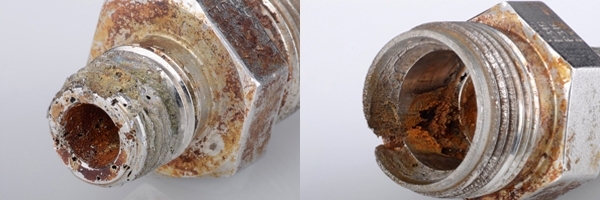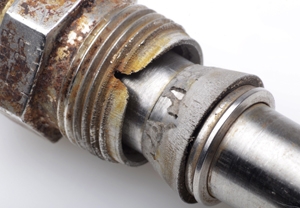Selecting materials for a given application is one of the main design steps towards a safe and cost efficient system, yet a commonly overlooked stage, mainly performed from a purely economic standpoint. The benefits of selecting the best candidate alloys and controlling corrosion are numerous and include asset safety and integrity, optimum performance with minimal maintenance and shutdown time or longer life expectancy. All those these advantages ultimately lead to considerable cost savings.
Using Higher Alloys For Critical Parts Only
Mixing dissimilar materials is a very common practice, more so when the alloy selection is primarily driven by cost and lead times. While there are numerous engineering applications where mixing dissimilar materials is not just an option but the best or only solution, there are many services where this practice does not add value and should be avoided. In the instrumentation market, Parker often encounters many customers experiencing corrosion problems. The most common solution in those cases is selecting new equipment made of a more corrosion resistant material to avoid a particular corrosion failure mechanism. Sooner rather than later, the cost of this new alloy comes into play and replacements need to be justified, so in an effort to try and keep this cost down, many customers decide to use this higher grade alloy in critical parts only.
How Can We Define What is Critical And What is Not?
Let’s take an instrumentation tube and fitting/valve system for example. The oil and gas industry has traditionally used millions of this type of instrumentation in 300 series stainless steel material. However, not only are climate and operating conditions, as well as geographical locations harsher than they used to be and so are the design criteria and safety regulations and expected life-span. Where stainless steel was a material of choice twenty years ago in these types of highly corrosive environments, it is not fit for purpose any longer. Corrosion resistant alloys are more readily available than ever, but their outstanding properties are proportional to their price per kilo. There seem to be a general line of thought that regards ‘bulky’ components as ‘durable’ or ‘unbreakable’. It is for those reasons that too often, the tube is regarded as the critical part (due to its limited thickness) and the fitting or valve as the ‘less critical’ one. Therefore, the higher grade alloy is selected for the tube and a lower grade for the fitting or valve. But, is this a fair assumption?
Does Size Really Matter?
If instrumentation products suffered from just general corrosion and were subject to no tensile loads, where steady corrosion rates can be established and risk managed fairly easily, the above assumptions could have been acceptable. However, the reality is that instrumentation products usually face both localised corrosion and mechanical challenges, due to their inherent operating conditions.
Typical failure mechanisms in the oil and gas industry are due to the action of localised corrosion, such as pitting or crevices. The combined action of a corrosive environment and the presence of tensile stress, such as vibration, can cause stress corrosion cracking and the fatal failure of equipment in a matter of seconds. Chloride induced corrosion cracking is a prime example of failure mode in offshore applications. It just takes the presence of tensile stress and a flaw in the material caused by chlorides, to start crack propagation. When there is a fissure in a material and the right amount of tensile stress, large thicknesses will not stop cracks propagating across the grain boundaries. It will just take a bit longer than with thinner sections. Therefore, in such cases, size does not matter.

Material Not Suitable For Tubing = Material Not Suitable For Fitting
Safe and cost effective operations should include the right selection of materials and a good design to minimise unnecessary loads. If a material is not deemed as suitable for tubing, it should not be deemed as suitable for another component, as after all, both parts will be exposed to exactly the same operating and environmental conditions, and thus are exposed to the same failure mechanisms.
According to industry standards such as NORSOK M-001: Materials Selection standard, ‘’wherever dissimilar metals are coupled together in piping systems, a corrosivity evaluation shall be made. If galvanic corrosion is likely to occur, mitigation methods should be used’’. It also states that ‘’at galvanic connections between dissimilar materials without isolation/distance spool, it can be assumed that the local corrosion rate between the interface is approximately 3 times higher than the average corrosion rate’’. Cathodic protection in instrumentation systems does not tend to be cost effective, and isolation or distance spool between the tube and the valve or fitting is often not viable.
Intermixing materials should never be taken lightly but carefully evaluated. Material selection is paramount in order to develop cost efficient systems, avoid unnecessary risk, jeopardise assets, add complexity or face costly downtime at a later stage. Selecting the right materials for the application, and ensuring a safe installation are common solutions to trouble-free systems and at Parker we have the knowledge and expertise to help you engineer your success.
Need help selecting the right materials? Talk to one of our experts today at
(855) 737-4715, or fill out our
online form.

